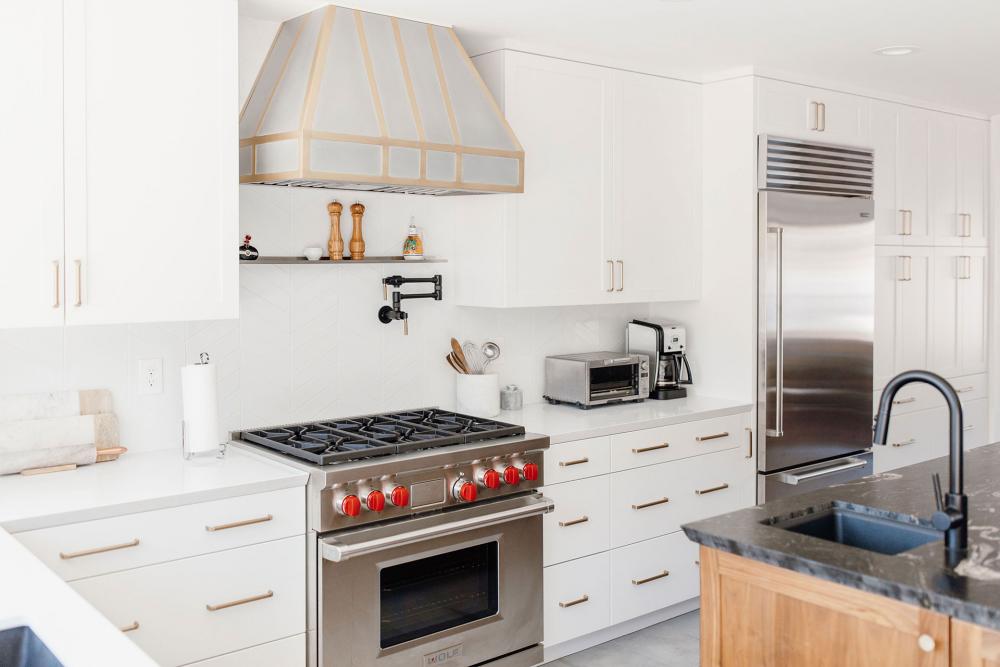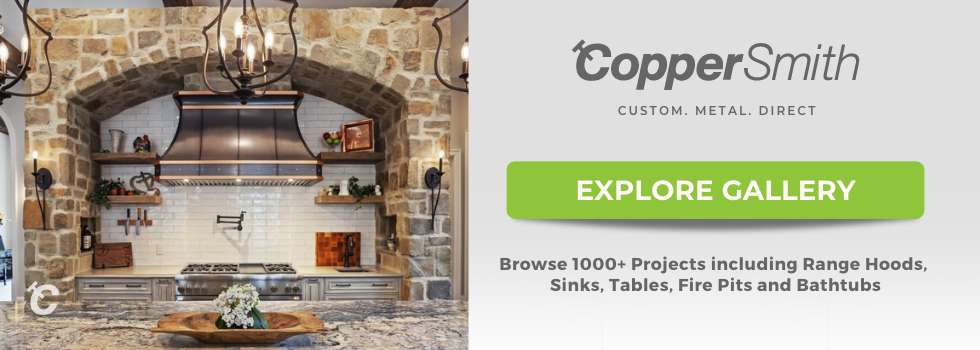
Also known as the exhaust hood, kitchen hood, a extractor hood or stove hoods are a critical appliance in the kitchen - it's designed to collect and filter out smoke, steam, grease, and odors produced while cooking. However, this system is as efficient as how well it is installed. And this is where the crucial question arises of whether the range hood has to be the same width as the stove.
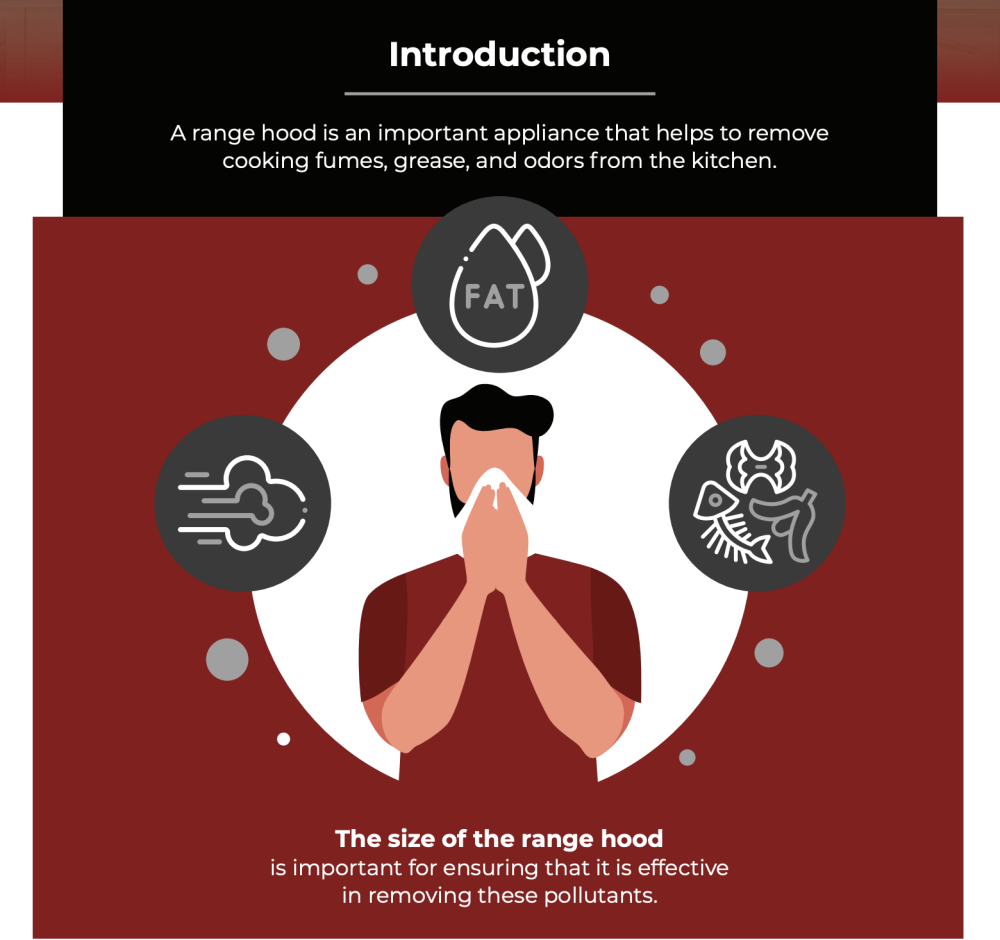
This guide answers this question and provides a comprehensive overview of the range hood, functions, and sizing requirements. By the end of this guide, you should be well-equipped to determine the best size for your range hood and install it safely and efficiently.
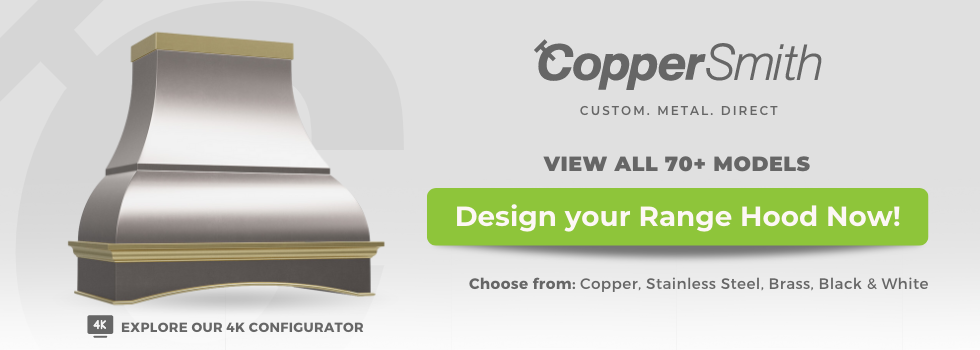 Short Answer: Does the Range Hood Have to Be the Same Width as Stove?
Short Answer: Does the Range Hood Have to Be the Same Width as Stove?
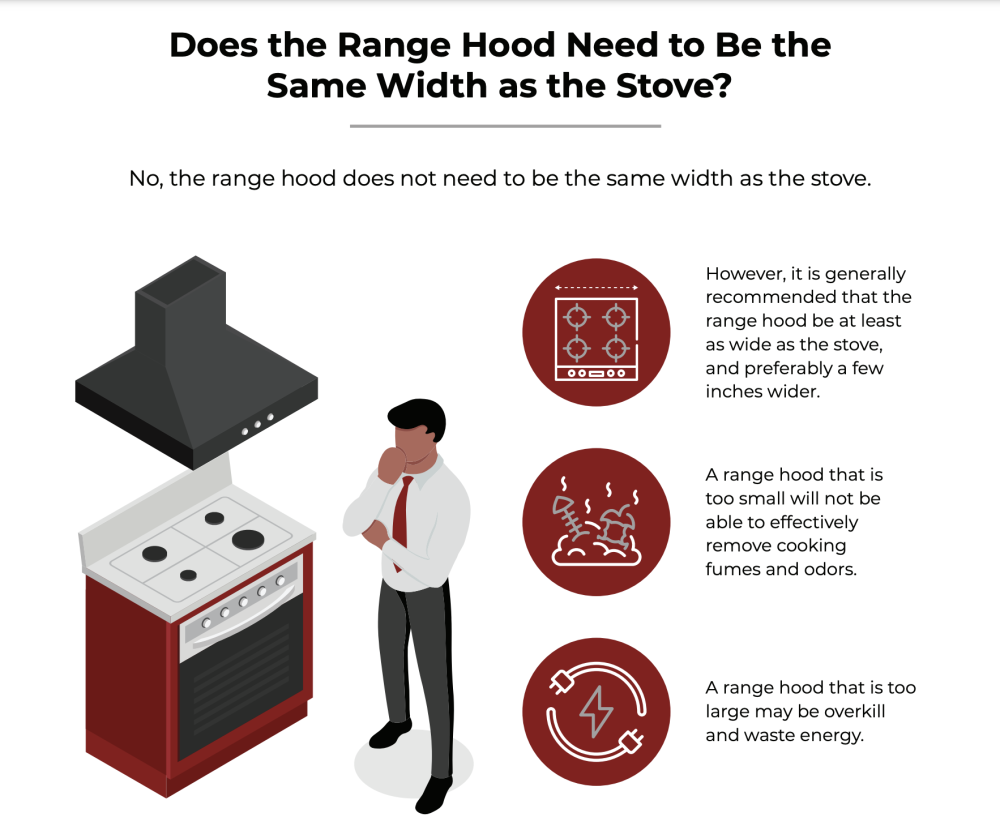
No hard and fast rule states the range hood has to be the same width as the stove. Nonetheless, the range hood should be the same width as the stove for maximum efficiency.
You may think you can use a range hood larger than the stove since you have the venting power. But this isn't necessarily the best option.
When choosing the size of your range hood, the goal should be to select one that covers the entire width of your stovetop or burners. Also, make sure the hood is well-placed above the burners.
You want a hood the same width as your stovetop to ensure maximum efficiency in air circulation. When you have one larger than your stove, not all venting power will be used, and some air may escape outwards rather than inwards towards the hood. A larger range hood can also be overkill and require more energy.
In the same way, if the range hood has a smaller width than the stovetop, it won't be able to capture all of the cooking vapors and heat efficiently. The result is a less effective range hood that may require more frequent cleaning or will do little to help prevent smoke or odors from spreading throughout your kitchen.
The other reason for having a range hood with the same width as your stove top is that it allows for a more streamlined look and can enhance the overall aesthetic of your kitchen. An oversized range hood may detract from the other elements in the room, particularly if you have a smaller or more compact kitchen layout.
Does the Hood Have to be Wider than the Range?
Ideally, having a range hood wider than the stovetop is optional. However, a hood that is wider than your cooktop has some benefits, as follows.
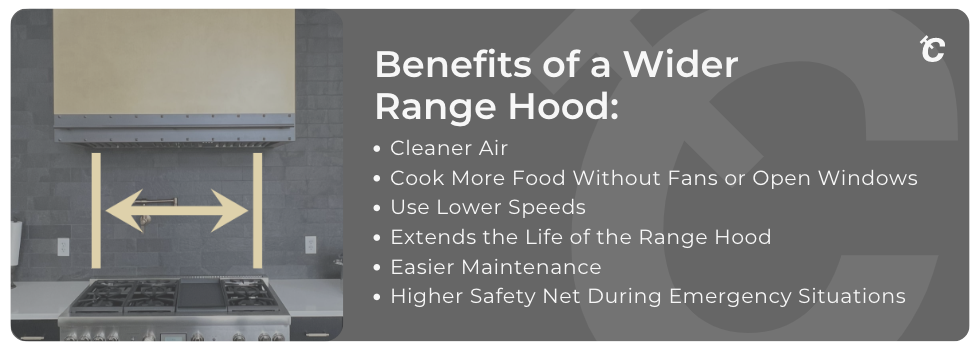
Cleaner Air
A wider hood covers more space, which minimizes the chances of smoke and grease particles escaping into the air. This perk reduces the risk of smoke particles and odors spreading throughout the house and ensures that smoke particles are not settling onto surfaces in other home areas. Thus, providing air quality is healthier in the kitchen and other living spaces.
Cook More Food Without Fans or Open Windows
A wide hood enhances the efficiency of the range hood, as it works to pull out more smoke and grease. You can cook multiple dishes without worrying about fans or open windows. The wide range hood also serves as a more effective barrier, blocking most smoke from escaping into other living spaces instead of becoming trapped in the kitchen area.
Use Lower Speeds
Having a wider range hood means you can use lower speeds for ventilation. Lower speeds translate to a quieter operation, maintaining a comfortable and peaceful atmosphere in the kitchen. Even when the hood is running, you can chat with your family and friends.
Furthermore, lower running speeds require less power to suck up the air in your kitchen for filtering. This benefit means lower energy consumption which helps lower your energy bills.
Extends the Life of the Range Hood
Wider range hoods are more effective at trapping smoke and grease, which means that there is less residue buildup inside of the hood itself. This helps to extend the life of your range hood by keeping it clean and well-maintained, allowing you to get more use out of it.
Additionally, the range hood does not have to overwork itself as much when it is wider. Therefore, the hood will only put a little strain on the motor and other mechanical parts, resulting in fewer repairs over time.
Easier Maintenance
A wider range hood is easier to reach, which makes it easier to clean. This means you don't have to worry about contorting yourself in awkward positions or using hazardous materials to eliminate the grime and grease. Maintaining a clean range hood is essential for keeping your kitchen air quality safe.
Higher Safety Net During Emergency Situations
When the range hood is wider, it provides a more significant safety net during emergency cooking situations. If something should happen with your stove or oven, the wider range hood will help to contain the flames and smoke more effectively. This perk can give you more time to address potential issues before significant damage occurs.
Can You Have a Smaller Range Hood Than a Cooktop?
Yes, you can have a smaller range hood than the width of your cooktop. However, there are some drawbacks to this choice.
It May Strain the Motor
If you choose a smaller range hood, the motor may need to work harder to provide adequate air circulation throughout your kitchen. Consequently, the motor will likely wear prematurely, which requires replacement.
Inadequate Coverage
The range hood aims to cleanse the air of smoke, odors, and other pollutants generated by cooking. A smaller range hood has smaller coverage than a larger one, so it won't be able to trap and expel all of these pollutants. This could result in unpleasant smells lingering in your kitchen and particles and grease accumulation on the walls and surfaces.
Noisy Kitchen
The motor works harder with a smaller range hood and will likely be noisier than a larger hood. The range hood requires higher power to offset the smaller size, which can result in a high-decibel humming that might be unbearable in your kitchen.
Incompatible Design
Having a smaller range hood could also disrupt the look of your kitchen. The range hood should ideally match the size of the cooktop and other appliances to complement their design, so having a significantly different-sized hood might throw off the layout of your kitchen.
Hard to Clean
A smaller range hood also means you have less surface area to clean and maintain. This can be especially problematic if you have an oily or messy stovetop, as it may be hard to effectively capture all the smoke and grease particles with a smaller hood. Additionally, because the fan is working harder to draw in the same amount of smoke and air, you may find that it gets dirty more quickly.
How To Choose a Range Hood
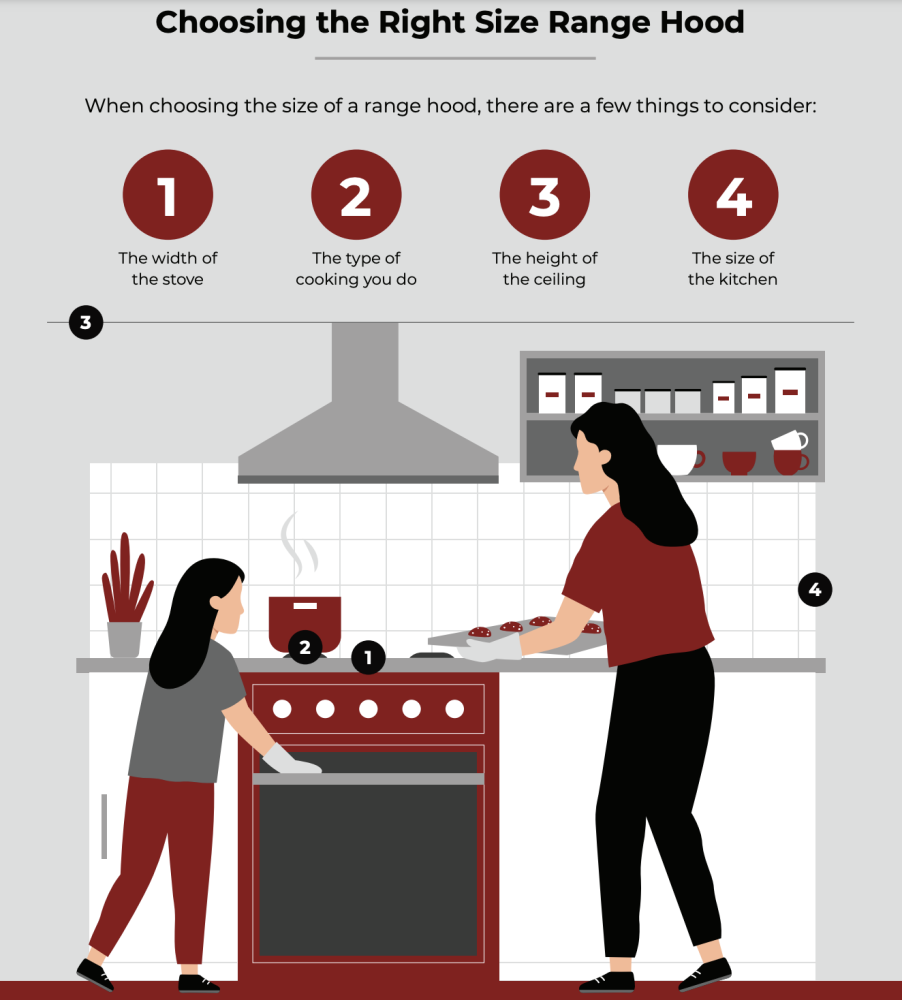
Now that you understand how range hoods work and how size determines their performance, here are helpful tips on how to choose the right range hood to suit your needs.
CFM
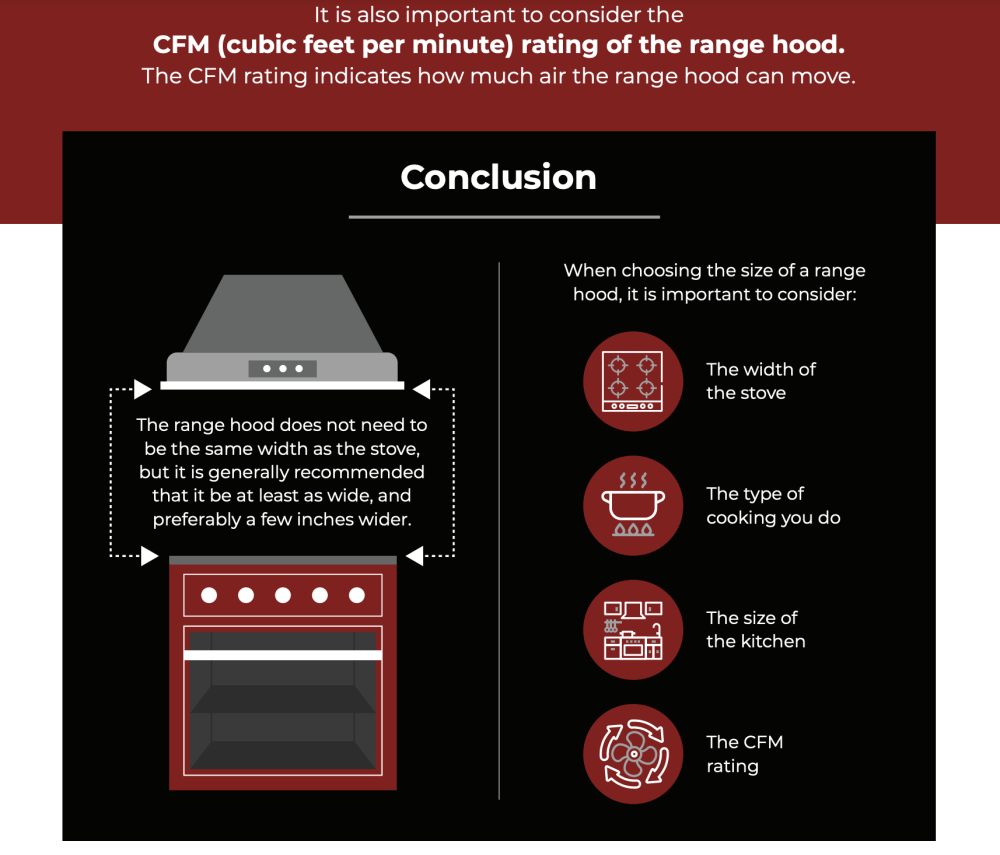
CFM stands for Cubic Feet per Minute, and it is the measure of airflow that a range hood can produce. The required CFM for your range hood will depend on the size of your cooktop or range. A general rule is 1 CFM rate for 100 British Thermal Units (BTU) of cooking surface. That means that if your cooking surface is 800 BTUs, then you would need an 8 CFM rate range hood.
Several aspects come into play when deciding the ideal CFM. For example, if you do a lot of heavy cooking that produces more smoke, then you will need a higher CFM and the right range size to efficiently take care of the smoke. However, if you just spend normal amounts of time cooking, a lower CFM and smaller size range hood can suffice.
The average CFM for residential range hoods is typically between 200 to 300 CFM. This number can go up to 900 for commercial setups such as restaurants.
Besides your cooking frequency, consider the range of hood sizes needed to cover your cooking surface. Larger ranges will undoubtedly require more powerful range hoods than smaller cooktops. Generally, the ideal size for residential range hoods is between 2 to 4 feet in length for standard rectangular designs.
Style
Range hoods come in a variety of styles to suit every kitchen's air purification and aesthetics needs. The style dictates the range hood mounts, and here are some of the most popular hood styles.
Wall-Mounted
This type of range hood is connected directly to the wall and can be easily adjusted according to your needs. These hoods are the best for smaller kitchens as they don't occupy too much space.
Wall-mounted hoods are also available in different sizes, so selecting the right size is essential.
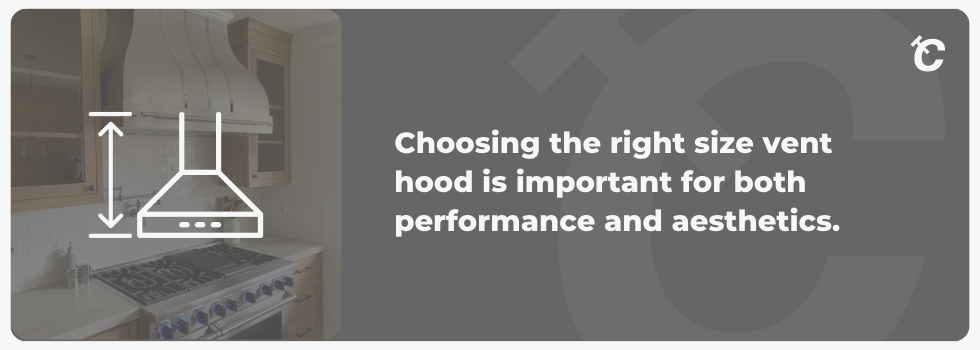
Island Range Hood
These hoods are suspended from the ceiling, making them a great choice for kitchens with islands or breakfast bars. Again, you have various island range hoods to choose from, including glass canopies and curved metallic hoods. If curved and canopy hoods are not your style, you may opt for traditional hoods, depending upon your kitchen décor.
Downdraft Hood
If you don't want your range hood to be visible all the time, downdraft hoods are your ideal choice. These kitchen range hoods are hidden in the cooktop and only pop when used.
The downdraft hood sucks smoke and steam horizontally from the cooking surface instead of vertically.
Range Hood Inserts
Also known as power packs, range hood inserts are the most popular range hoods due to their easy installation and quiet operation. The hood inserts are hidden behind cabinetry and have various sizes that match your kitchen décor.
Custom Range Hood
As the name suggests, these hoods are personalized per your specifications and design. The hood sizes, shapes, styles, finishes, and colors are all customized. They are usually used for luxurious or modern kitchens requiring special attention to detail and aesthetics.
Under-cabinet Range Hoods
Under-cabinet range hoods are great for kitchens with limited space or those that have a cooking surface wider than your cooktop. These hoods can be installed underneath cabinets. The range hoods come in sizes ranging from 1 to 4 feet.
Under-cabinet range hoods are best suited for gas stoves, as they capture most of the grease, heat, and smoke emitted when using the stovetop.
By understanding the different vent hoods and how each type works, you can make an informed decision on the best hood to use in your kitchen.
The Filter Types
The kind of filter you choose for your range hood will significantly dictate how well it functions. The most common type of filter used for range hoods is charcoal filters, which are mostly ideal for ductless range hoods. The charcoal filters feature carbon-based material, allowing them to filter out and deodorize the kitchen air.
Other range hood filter types are aluminum mesh and stainless steel baffle filters used for ducted range hoods. The aluminum mesh filter traps grease, while the stainless steel baffle filter produces more powerful airborne particles and smoke filtration.
Measuring for a Range Hood
Learning how to size a range hood is the most important when it comes to selecting the best range hood for your kitchen. You need to select a size that is wider than your cooktop or range and, if possible, one inch higher than your cooking surface.
The standard range hood dimensions for most range hoods follow the 3-inch rule, whereby the width should be 3 inches wider than the range on both sides. So, if your cooktop is 30 inches wide, you would need a range hood that is 36 inches wide. Here are helpful steps to determine the right range hood sizes.
Measure the Cooktop's Width
You can use a measuring tape to measure the width of the cooktop. Ensure the tape is running parallel to the cooktop's front edge while at the same time accounting for any overhang like a backsplash.
Measure the Width of the Space Between Cabinets
The range hood you choose should fit snugly between two wall cabinets or open spaces. Therefore, you must measure the width of the space where your hood will be installed.
Determine the Height over Cooktop
Range hoods come in various sizes, each suited for a certain height above the cooktop. Once the hood is installed, there should be about 24 to 36 inches between the top of your range and the bottom of the range hood.
Check the Depth of the Cooking Surface
When measuring the depth of the cooking surface, you should exclude any handles or knobs attached to the range. If you have a range with a cooktop, measure the depth of the burner grates, not the entire cooktop.
The range hood dimensions will help you establish the right range hood size and mounting height. Note that it would be best to let a professional installer measure the dimensions for an accuracy guarantee.
Brand
Finally, you certainly want to get value for your money. And you can only get the most out of your range hood if the quality is top-notch.
So, take your time to research a brand that offers quality and durability. Read reviews and find out what others think of the hoods they purchased. Pay attention to the hood’s reliability and efficiency, then consider the traits to the price. It would be better to pay a higher price for a durable range hood than spend less on a hood that will demand replacement after a few times of use.
You may also consult an expert to help you, considering that the specialists have dealt with various brands and can advise you accordingly.
FAQs
Here are some commonly asked questions about range hoods to help you make sound decisions.
Can you use a 30-inch hood with a 36-inch cooktop?
The answer is yes, but since the hood is smaller than the cooktop, you will be setting yourself up for an inadequate ventilation system. The hood is also likely to wear out prematurely due to the excessive strain on its components.
Furthermore, smoke and grease may not be adequately evacuated from the kitchen due to inadequate air suction. Therefore, it is advisable to use a hood that matches or slightly exceeds the size of your cooktop for optimal performance.
What size range hood do I need for a 30-inch cooktop?
The thumb rule is to select a hood 3 inches wider than the cooktop on both sides. The ideal hood size for a 30-inch cooktop would be a 36-inch range hood. This difference offers adequate coverage to remove smoke, steam, and grease from your kitchen.
Improve Your Kitchen's Air Quality With Correctly-Sized Range Hoods
Range hoods are a wise investment for any kitchen, as they help to improve kitchen air quality and reduce the buildup of smoke, grease, and odors. But the size of the range hood that you choose is critical. Pay attention to the factors discussed above when selecting a range hood for your kitchen, and ensure that you get the size right to ensure maximum performance.





